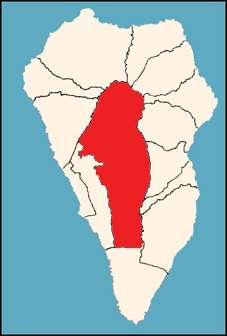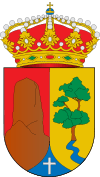El Paso, La Palma
| El Paso | |||
|---|---|---|---|
| Municipality | |||
| |||
 | |||
 El Paso Location in Canary Islands | |||
| Coordinates: ES 28°39′N 17°53′W / 28.650°N 17.883°WCoordinates: ES 28°39′N 17°53′W / 28.650°N 17.883°W | |||
| Country | Spain | ||
| Autonomous community | Canary Islands | ||
| Province | Santa Cruz de Tenerife | ||
| Island | La Palma | ||
| Area[1] | |||
| • Total | 135.92 km2 (52.48 sq mi) | ||
| Population (2013)[2] | |||
| • Total | 7,928 | ||
| • Density | 58/km2 (150/sq mi) | ||
El Paso is a town and a municipality on the island of La Palma, Province of Santa Cruz de Tenerife, Canary Islands, Spain. It is situated in the middle of the island. The population of the municipality is 7,928 (2013)[2] and the area is 135.92 km²,[1] making it the largest municipality on the island of La Palma. The mean elevation is 600 m. The territory of the municipality includes the Caldera de Taburiente, a giant caldera constituting a national park.
History
Many footpaths already crisscrossed La Palma before the Spanish conquest. A number of mountain passes east of present-day El Paso enabled cross-island communications. One of these was Ajerjo Pass by which the island's Spanish discoverer, Alonso Fernandez de Lugo, attempted to enter the Caldera de Taburiente, hence its local name the Captain's Pass (Paso del Capitán). The village of El Paso was named after this mountain pass by association.
On 3 May 1492 the mentioned Fernandez de Lugo finishes the conquest of the island of La Palma by the Spanish when conquering the last remaining stronghold of the native Guanches, the kingdom of Aceró. To this goal, Fernandez deceitfully invited its king Tanausú to an interview, to have him imprisoned on appearance. The island was made directly subject to the Spanish Crown, a situation which would last until 1812. In this year the new Spanish Constitution paved the way for decentralisation of the Canary Islands and subdivision into municipalities.
Historical population
| Year | Population |
|---|---|
| 1991 | 7,010 |
| 1996 | 7,006 |
| 2001 | 6,764 |
| 2002 | 7,438 |
| 2003 | 7,544 |
| 2004 | 7,218 |
| 2013 | 7,928 |
See also
References
- 1 2 Instituto Canario de Estadística, area
- 1 2 Instituto Canario de Estadística, population


